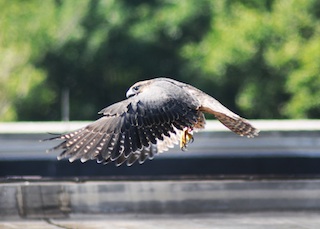
The University of Michigan has tailored various construction projects to be appealing to the eye, eco-conscious – and, now, friendly to the state's endangered wildlife species.
Since 2006 a pair of peregrine falcons has nested on various top stories at the university. In May of this year, atop U-M Hospital, that couple proudly became a family of five.
"We've been hoping [the peregrines] would be successful for years, and finally we have success and it's at the hospital, which is kind of ironic," Heather Rice, an environmental specialist at U-M, laughs. "We have our first chicks born at the hospital, which is good."
But there was some separation anxiety among the brood and interested observers shortly after the birthing. One of the chicks – a daughter – unable to return to the nest after a shaky test flight, was found, rehabbed, and banded by the Michigan Dept. of Natural Resources (DNR) and has recently been returned to Mom and Dad. The reunited quintet now rests in a new nesting box atop the hospital roof. They're visible from a courtyard on the south side of the hospital, or from adjacent parking structures.
The chick trio is a fortuitous gift to wildlife watchers, as last year's attempt at hatchlings was a washout. The parents had nested on an upper roof at Burton Memorial Tower – in a gutter. The eggs couldn't withstand heavy spring storms. "So that's what led the university to install the two other nesting boxes," explains Michelle Smay, senior architect with the U-M Dept. of Architecture, Engineering, and Construction.
An Eagle Scout built the boxes, which were installed at
U-M Hospital and
North Quad after some modifications by university personnel. The wooden shelters are roughly three feet square, open on one end, and have a pea gravel bed in the bottom. Peregrine falcons lay their eggs in divots in the gravel.
To further the DNR's study and tracking of this endangered species, university officials plan to add an access hatch to the box at U-M Hospital. "The hope is that we can get up there and retrofit that box to put in an access hatch and make it so that if there is success next year...we can have the whole brood banded all at once," Rice says.
Incidentally, last year the falcons built their nest on the peak of
Burton Memorial Tower while it was undergoing repairs to its limestone exterior and restoration of the carillon and an internal steel structure supporting the carillon's 55 tons of bells, Smay explains. After checking with an environmental consultant and the DNR, university officials ceased all work on the tower until after the nesting season. But life goes on – the exterior is now complete, and the falcons are safely bedded at the hospital. And Smay says the carillon restoration should be done by summer's end.
A hypothesis worth an ear or two: As a parallel to the Mozart effect, in which people exposed to Mozart music showed an improvement in spatial reasoning, could falcon chicks exposed to the Burton Tower bells better their flight skills? Maybe, if the falcons hear the chimes from their perch on the hospital roof.
"I think they probably can, yes," Smay laughs.
Sources: Heather Rice, environmental specialist at U-M; Michelle Smay, senior architect with the U-M Dept. of Architecture, Engineering, and ConstructionWriter: Tanya Muzumdar
Image courtesy of the University of Michigan
Enjoy this story?
Sign up for free solutions-based reporting in your inbox each week.